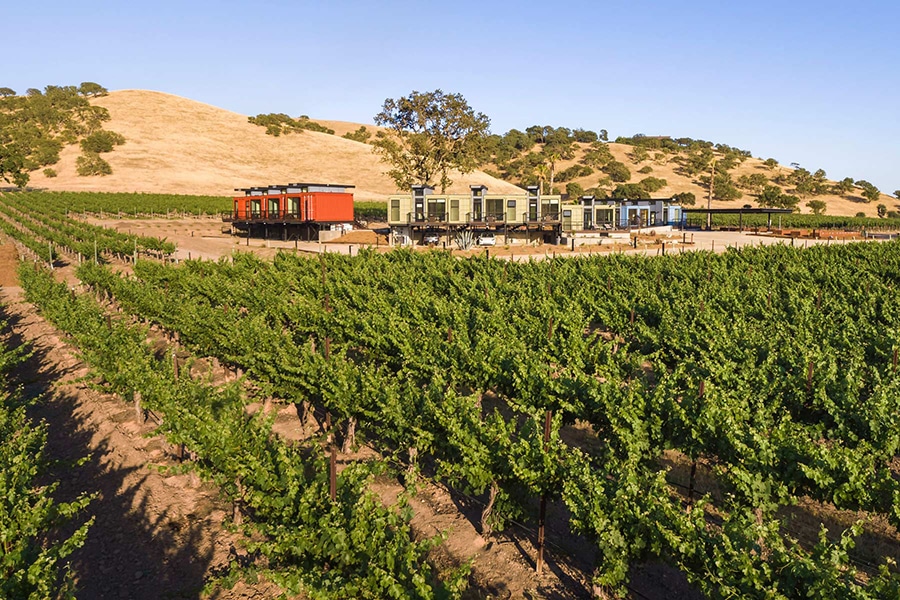There’s never been a greater time to start thinking outside the box by living inside a box…literally. Whether you’re currently dreaming of owning your own tiny home, a house hunter who wants something unique or perhaps looking at adding a granny flat or home office. The new designs and ideas for homes made from shipping containers, cabins on wheels, or tiny permanent dwellings are endless.
With the latest news indicating a surging property market and dwindling vacancy rates for renters, investors are starting to think about how a tiny home could double as a granny flat, Airbnb or extra space to rent without breaking the budget on a massive renovation or new build.
The new trends of tiny homes and container living could be the answer. Not only are people jumping on this for homes, but hoteliers around the world see the benefits of how these unique dwellings can be made into stunning hotel accommodations.
And just when you thought the concept of flat packing couldn’t get more involved, you guessed it, the giant of everything flatpack, Swedish furniture company IKEA, is set to jump on the trend. IKEA has introduced prefab houses through their tiny homes project in the overseas market, designing 17.5 sqm abodes on a flatbed trailer. They are set to take the industry by storm with their partnership with Vox Creative and RV builder Escape. While there is no word on when the tiny homes are to be introduced to the Australian market, the way this trend is rising in Australia, we don’t think it will be long.
https://www.instagram.com/p/CMEfHiNqqwg/
7 Benefits to Owning a Tiny Home
1. Cost effective.
Tiny homes are typically cheaper than building a traditional home and generally require fewer building materials to construct.
2. Quick to construct.
A tiny home can take only a couple of months to construct depending on the building supplier and whether they are a free-standing or flat-packed model or shipping container structure.
3. Modular.
You can purchase various sized containers for a tiny home to have a modular design or add to them later. Think Lego designs and how you can add to the structure.
4. Durable.
Many tiny homes in Australia are made with durable and sustainable materials to withstand heavy weather, storms and harsh environments. Shipping container models are especially popular for their ability to withstand the harshest of environments.
5. Mobile.
If you relocate, you can have your tiny home moved to your next destination. They can also be moved easily anywhere on your block just like you could move a campervan trailer.
6. Create a second income.
Many people see the benefit of creating a second income by renting tiny homes on the Airbnb holiday market or more of a permanent rental accommodation on their land instead of constructing granny-flat renovations on their main residence.
7. Eco friendly.
Minimalism and sustainability are on everyone’s radars, and tiny homes are made with fewer materials and easily built with sustainable and recycled materials. An average home will use seven truckloads of timbers and bricks to construct a standard sized home, whereas a tiny home will only use half a truck size. Tiny homes can also be easily set up with solar panels and water tanks to preserve and give back to our natural resources.
https://www.instagram.com/p/CLajRHunZwR/
How to Build a Tiny Home
Tiny homes can come in various interior design options from modern, eclectic, shabby chic, boho chic, industrial, or however you’d like your design style to be. They can be architecturally designed with joining platforms, decking, pools, windows, and even glass walls. The sky is the limit on how simple or elaborate you can make a container home.
Building tiny homes with shipping containers.
Using metal shipping containers for building materials is also emerging as a growing trend because they serve as a unique, robust, cheap and sustainable way to build a new home or dwelling.
Whether your idea is to have a small space for a work office, granny flat, cabins, or gym, people utilise containers to fit their needs and enhance their home lifestyle. Simple designs can incorporate small decks, a few windows and a small kitchen and bathroom, and a very low-cost solution for a small dwelling.
Here is some inspiration for what can be achieved with shipping containers:
Examples of shipping container tiny homes:
ecotec design, a Los Angeles-based studio, completed an eco-friendly shipping container hotel in a winery in California, offering a design that integrates 20 steel shipping containers with conventional construction and local building materials set in the middle of 145 acres of grapevines.

In Germany, a building start-up company (Containerwerk) has turned old shipping containers into 21 micro apartments for visitors to say due to a shortage of accommodation in some small village towns. This is an excellent idea of how containers can be arranged in groups and clad in timber to give them a modern and warm home feel rather than a purely steel industrial look. Each apartment has a separate bathroom attached to the end of the container, and the glass windows and doors are designed to maximise the daily sunlight.
https://www.instagram.com/p/B-7M7xTnoEu/
Shipping container pools
Pools are another way people utilise shipping containers and establish them into new builds on their properties. Homeowners are beginning to understand that a shipping container can provide additional benefits that the traditional pool can’t, such as being lowered and built surrounding hard to reach and sloped blocks. They can be installed in one day and don’t need any digging into the ground like traditional in-ground pools.
https://www.instagram.com/p/CI1s14PlpDL/
5 Space-Saving Interior Ideas for Tiny Homes
https://www.instagram.com/p/CMN6irLiN_i/
https://www.instagram.com/p/CMk1JdrH7g6/
https://www.instagram.com/p/CMnt8G3MJHd/
https://www.instagram.com/p/CMx94mZhOeR/
https://www.instagram.com/p/CMxgLBUHrGz/
Want to know more about tiny homes?
Contact your local builder on localsearch.com.au to find out about how a tiny home in Australia could work for your lifestyle.





